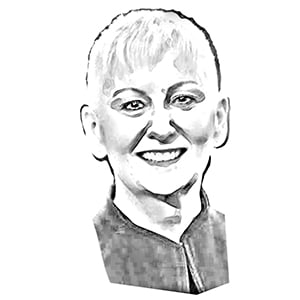In 2007, Byron Reeves, Professor of Communications at Stanford University stated: “If you want to see what business leadership may look like in three to five years, look at what’s happening in online games.”
In the few years since, if you have been watching the battle between Fortnite and Apple, the future is exploding and it’s of leviathan dimensions. The online games industry is economically massive, expected to reach $300 billion by 2025 with over 2.5 billion gamers.
What does this mean for jobs? Well, why not ask the kids?
Recently, a colleague posted on LinkedIn, her eight-year-old son’s hand-written note of his goals. “Get laptop, iPhone, Apple watch, Apple Mac.” And then “become TikTok famous”.

So we need to listen. And think. And get close to the pulse of the future.
Like Dr Jenine Beekhuyzen the founder of the Tech Girls are Superheroes, who in #NationalScienceWeek delivered a 2-day virtual design challenge to regional NSW school girls: “think differently, break things (including ideas)”.
Like the phenomenal work of the Australian startup Indigital, leading the world in Indigenous digital skills training program that combines Cultural Intelligence with Digital Intelligence, using animated 3D augmented reality.
Unlike many people, kids would not be surprised by a recent article that ‘robot influencers’ – software that looks like sophisticated human-like avatars – have millions of fans and followers and earn tens of millions of dollars every year.
But stop for a moment and think about that: virtual beings earning tens of millions of dollars.
Not even human influencers are safe from disruption. Next will come the news readers. Weather readers. University lecturers. And actors. All very easily disrupted by the digital human innovation.
Last week, on a call with a colleague who runs an AR/VR/animation company in Hollywood, he commented that on-set physical production of films has stopped due to COVID19 – but the animation and digital human business is booming. Borders and physical presence do not matter. And unlike human influencers and actors, the digital humans are endlessly adaptable.
Speaking at the Cucalorus Independent Film Festival last year, screen writers, producers and gaming companies are already working at the intersection of the creative arts and healthcare, creating new domains of human experience services.
And in one of the most visceral of human experiences, cooking and the enjoyment of food, Culinary Clones is breaking new ground, using advanced digital technologies for a highly immersive, entertaining and informative culinary experience.
So, does the Australian Government Jobs in the Future Overview, have digital influencers, clones, massive online gaming design, cultural intelligence and digital companion design on the future jobs list? These skills and servicing innovations – like a leviathan – are reaching deeply into all sectors, upending and creating new sectors.
Instead, government issues laborious statements such as: “workers will need both technological skills and the ability to apply other skills … in a technology-rich context.”
What does this even mean?
It was only a few years ago, that the Australian Public Service Commission’s APS Leadership and Core Skills Strategy (2014-15 Refresh) – a strategy that looked at the long-term drivers impacting the APS as an institution – completely failed to mention the word ‘digital’.
What this actually means, is that notwithstanding the billions of dollars spent on consultants, technology and digital strategies, the digital revolution has utterly passed over government policy and service delivery, at warp speed.
Ill-prepared, we are left in the pandemic with Zoom-for-everything and the 160 year old telephone. Just imagine where we would be with no Zoom.
And the tragedy of the fragile Byzantine aged care system and disability services, is that whilst these are the epicentre of the ‘jobs growth’ in the traditional sense – more of the same will not fix the problem.
The problem is, the government’s forecast of 70,000 jobs is more of the same, viewed through the mental model of last century.
For years, the Productivity Commission has been warning that the traditional and templated approaches to service delivery have not worked and that only innovation can address the increasing demands on services from an ageing population.
The 2016 Senate Inquiry into The Future of Australia’s Video Game Development Industry acknowledged the growing demand for gaming innovations in health, education and training. But even with the Government’s National Innovation and Science Agenda, the Senate Inquiry lamented:
“…it is not apparent that the Government has given explicit attention to interactive game development and the potential for Australia’s future that this industry could provide.”
So the government’s ‘jobs of the future list’ related to aged care and disability makes no sense.
As we face into the third decade of the 21st century, in the midst of a global pandemic, the real question is, how are people supported throughout life with dignity, safety, enjoyment and independence?
From my experience, the core of the aged care policy failings – which is impacting current and future jobs preparedness – is ageism and a bureaucratic disinterest in an innovation future.
That aged care and disability policy is devoid of critical innovation is a catastrophe we are witnessing.
I was told by a very senior bureaucrat still serving, that there is no time “for this future stuff”. David Thodey made similar observations.
Critically, we need to challenge ageism in policy, which makes assumptions about “old people”.
Assumptions that “old people don’t use technology”. Perhaps understandable if the question is about “government technology”: the Aged Care Portal, MyGov and the like.
But old people – and people with disability – are innovators and avid users of technology. They are some of the most radical and experienced gamers.
70,000 of the same jobs of today – for the future – is a meaningless statement.
Technology as part of an augmented care ecosystem would see robots, smart home sensing technology and digital companions in people’s homes. And in supported accommodation.
Companion systems that are co-designed and trained by humans – that have a personality and domain specific roles. Just look at the Virtual Beings Facebook group, with over 3,500 members globally: this field is exploding and rapidly changing entertainment and healthcare. And #Nadia has a special place amongst this community.
Think about the grey nomads whose vehicles are literally mobile satellite communications units. Out exploring … doing work … creating … remotely. “Old people” like me.
The COVID-19 pandemic has massively accelerated the adoption of remote working platforms whilst, at the same, time smashing the “commute to physical workplace” paradigm inherited from industrialisation.
Overseas corporations will source our best without all of the visa blather in their own countries or ours. They will work on-line, and the time zone differences won’t bother them.
What is actually happening, is not on the government’s jobs of the future list.
At a US hospital I’m helping, drones are being trialled to deliver PPE to minimise infection risk from delivery drivers. Utilities around the world have been using drones for some time to remotely inspect valuable infrastructure. Thousands of highly skilled technicians have been displaced.
Policy makers should get along to the World of Drones Congress to see the rapidly evolving new jobs and roles, and how organisations and boards need to urgently adapt.
Faced with a recruitment shortfall, the US Army is utilising the popularity of esports and gaming to increase awareness and reach, to the highest level in the history of the all-volunteer force: far higher than website and traditional recruitment channels.
An Army recruitment officer commented: “It’s essentially connecting America to its Army through the passion of the gaming community”.
Significantly, the senior leadership of the Army were not aware of the appeal of eSports, now with hundreds of millions of players worldwide.
And the applications go far beyond Army. eSports and exponential technologies are rapidly driving phenomenal innovation in service design and new servicing models in healthcare and government servicing (are we brave enough?)
Avatars operating within the virtual world such as Second Life are being used in the rehabilitation of service veteran amputees. As a veteran family, I ask why are these not in use in Australia? Perhaps avatar trainers are not on the government’s jobs list.
Digital humans such as SimCoach have been used for many years in the US in mental health settings, monitoring for signs of PTSD in veterans and service personnel.
And can you imagine a chip enabled software driven smart exoskeleton as a telehealth channel? Happening now, but Byzantine policy does not even contemplate this as telehealth. Imagine a physiotherapist on the east coast being able to undertake a consultation with a patient on the west coast by logging into the exoskeleton in use. This would not only be life changing for many people, but would accelerate the demand for new support services, including export services.
So where is IoT as a telehealth channel on the “digital transformation agenda”? Or on the government’s jobs of the future list?
What I would offer is this.
The eGames and online gaming innovations and technologies are radically reshaping entire economies and servicing industries. This is why Apple and Fortnite are locked in battle.
At a time when we are in dire need, Australia is fast being left behind and will be unable to compete globally due to Government inaction and a disinterested bureaucracy.
eGames and online games are tools that can be used by everyone from infants to our oldest citizens. And people with disability are amongst the most ardent gamers.
In many ways, if you want to know what the future of jobs looks like, ask a gamer.
Marie Johnson was the Chief Technology Architect of the Health and Human Services Access Card program; at Immigration headed up the Visa Pricing Transformation and Digital Client Services; formerly Microsoft WorldWide Executive Director Public Services and eGovernment; and former Head of the NDIS Technology Authority. For many years, Marie was an independent member of the Australian Federal Police Spectrum Program Board. She is an inaugural member of the ANU Cyber Institute Advisory Board.
Do you know more? Contact James Riley via Email.

